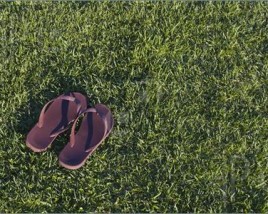Summer Lovin’ for Your Lawn

While Spring is all about greening up your lawn, Summer is about keeping it healthy and green. Summer brings a lot of really great benefits, but sometimes too much of a good thing can take a toll on your lawn. It is important to consider that rising temperatures and dissapearing rainfall can undo all your hard work if you are not careful.
Summer Lawn Care Tips
We would like to show you a few tips to help your lawn withstand all Summer has to offer.
Weeds Weeds Weeds – Fighting back against broadleaf weeds is a constant battle, but Summer can make the battle even more frustrating. Summer weeds go from germination to seed very quickly. This is why it is important to spray them regularly as they become active to prevent as many from producing seeds and infecting your lawn as possible. We will spray with your regular treatment, but if you are continuing to see issues 2 weeks after treatment, please give our office a call 855-469-0692 to set up a FREE service call to keep weeds from overpowering. Please keep in mind that the best defense is a thick, healthy lawn making weed control only part of an effective maintenance schedule.
Grubs & Other Pests – Just like weeds, insects can cause extensive issues for your lawn. One insect can lay thousands of eggs that will have a huge impact not only this season, but well into the future. Grubs are the larva of Japanese and June Beetles. These pests live right under the surface of your lawn and can destroy a healthy turf in weeks! Once grubs have begun to feed on your lawn’s roots, it is too late making preventative measures the only way to be sure your lawn will not be affected. Our pre-emergent Grub Control is applied in the early Summer before grubs hatch and is 100% guaranteed!
Another type of pest to consider is surface feeding insects. While grubs are located in your soil, these pests sit on the grass blades and suck the nutrients from your lawn. Some of the most obvious signs of an infestation are when your lawn begins to thin and lose color. Sod Webworms are a big issue in our area and will leave pencil-sized holes in your grass. We recognize that there is a consistent issue with these pests and include 2 FREE surface feeding insect controls during the Summer along with your regular treatments of fertilizer and weed control.
Mowing – Mowing height can make or break your lawn during the Summer. It is important to remember that your lawn is under A LOT of stress during this season and your job is to help, not harm. The height of your lawn should be at 3.5”, if in doubt, set your mower as high as it will go. Tall grass provides many benefits towards maintaining grass and soil health. When grass is cut high, the plant is able to obtain more sun during peak hours to create energy that will inturn provide more nutrients to both the plant and the surrounding soil. Tall grass also provides more shade for the soil, allowing it to hold moisture longer through the dry heat of Summer days.
Another factor of mowing in the Summer is that your schedule will have to change. Spring brings a growth spurt to your lawn due to warm germinating temperatures and excessive rain. As the rainfall decreases and harsh heat sets in, your grass will switch from growing to maintaining. All its energy will be used to gather as many nutrients and water as it can to protect itself and therefore its growth will slow. Now is the time to mow less frequently and invest your time in watering to assist your lawn in its defence.
Watering – Most lawns in our area consist of cool-season grasses, and as Summer heat sets in, they will naturally go dormant to protect themselves. Now is the time to make a BIG descicion; decide to water your lawn no matter what OR let it go dormant. At no time during the Summer should you ever allow your lawn to turn brown and then decide to water to switch it back to the lawn you remember from the Spring. By doing this, all the energy that your lawn has saved in its dormant stage will be released, depleting the reserves that were keeping the lawn alive and stressing the plant.
Lawns need to be watered deeply and infrequently. To combat the lack of rainfall, a lawn will need 2” of water per week on average. It is important to water early in the day (5am – 9am) and allow it to soak deep into the soil. If you have chosen to let the lawn go dormant, this does not mean it no longer needs water! To maintain the plant for when cooler temperatures creep back in, 1/2” of water is needed every 2 weeks to keep the dormant tissue alive. Once the temperatures break as we enter Fall, the lawn will break dormancy and green-up.
Read More: Round 3, Grub Control, Watering Techniques